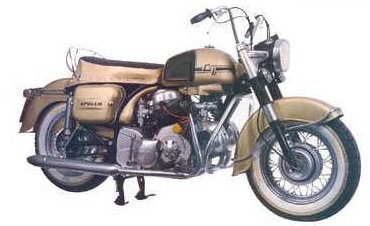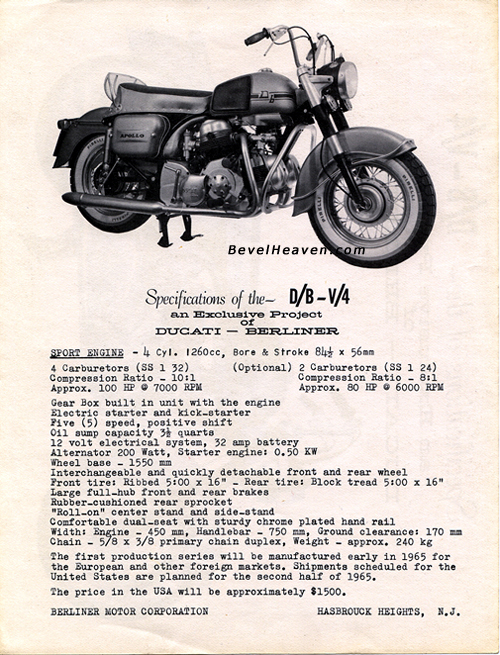
Announcement
Collapse
No announcement yet.
Announcement
Collapse
No announcement yet.
desmo v4
Collapse
X
-
-
The 40-year gap between the 1963 Apollo and the '03 advent of the 990cc MotoGP desmosedici was neatly bisected by a third, little-known Ducati V-four prototype engine--the so-called Bipantah. Conceived by Taglioni on the eve of his retirement and coming much closer than many people realize to supplanting Massimo Bordi's V-twin desmoquattro project, the Bipantah was a significant design.
Drawn up under Taglioni's supervision in January '81 by Pierluigi Mengoli, Ducati's current head of engineering, the Bipantah, as its name suggests, essentially represented a pair of Ducati's existing 500cc ,Pantah V-twin, belt-drive, SOHC, desmodue engines twinned together to produce a 1000cc V-four. Created one year before Honda stamped its mark on the V-four-engine concept with the '82 launch of the VF750, the Bipantah was conceived as a means of allowing the company to ensure its future existence. Ducati had passed into the hands of the Rome-based VM Group in '78, a state-subsidized manufacturer for which motorcycles were a low priority. And with worldwide bike sales declining, and twin-cylinder bikes unfashionable and disregarded, Ducati's future looked bleak. A range of V-four models seemed the best hope for future survival.
The Bipantah project was clearly the pinnacle of Taglioni's lifetime in engineering, and represented the fulfillment in metal of his first-ever complete engine design: the 250cc, 90-degree V-four he produced in '48 as his mechanical-engineering degree project. With a bore and stroke of 78mm x 52mm for a capacity of 994cc, the design was the most oversquare of any Taglioni engine, primarily to reduce engine height and length. Even so, the complete engine was just 100mm wider than the Pantah V-twin it was descended from, with the rear pair of vertical cylinders sharing a common block and two separate horizontal cylinders sitting outboard. The format provided extra room for front-wheel deflection under braking, though the differentially finned cylinders were tilted 20 degrees backward on the vertically split crankcase to further reduce length and enhance cooling of the oil/air-cooled motor; Taglioni's dislike of liquid-cooling for thermodynamic reasons, as well as increased bulk and weight, dictated this solution.
Taglioni was equally prejudiced against employing four valves per cylinder, meaning the V-four featured desmodue cylinder heads with a single camshaft per bank driven by a pair of toothed belts, Pantah-style. A 50-degree included valve angle provided the best cylinder filling, with electronic ignition firing a single 12mm plug per cylinder, and four 40mm Dell'Orto carbs facing forward and mounted on long, curved intake stubs for maximum ram-air effect. When I first saw the engine in early '82, Taglioni was eagerly awaiting the arrival of an electronic fuel-injection system from SPICA, then suppliers of fuel injection to the Alfa Romeo F-1 team (though the project was cancelled before this materialized). One year later, the BMW K100 was introduced with the Bosch electronic fuel injection Taglioni had always wanted to employ; he hated carburetors on the grounds that they were "inefficient, outdated and don't permit economy allied with performance.
The Bipantah's pistons were a two-ring design in an effort to reduce friction without suffering oil blow-by problems, while the one-piece plain-bearing crankshaft saw each pair of con-rods sharing a common crankpin. Power was fed via a large-diameter dry clutch mounted on the right side of the engine to the five-speed gearbox that for the first time on any Ducati was a fully extractable cassette-type cluster, just as on today's new desmosedici. Although conceived and developed as a one-liter sportbike motor, Taglioni envisaged the Bipantah being bored and stroked up to 1150cc if necessary for sport-touring purposes or for the police market (shades of the Apollo!), and wanted a transmission capable of harnessing the extra power.
How much power did the V-four make in 994cc guise? "It was the most successful engine I ever designed, almost from the first dyno run," Taglioni told me as we stood looking at it in '84. "With little development, fitted with touring cams and silencers meeting all current worldwide restrictions, it initially produced 105 horsepower at 9500 rpm at the rear wheel. With more extreme cams and valve timing, and open exhausts, we later [achieved] 132 hp at 11,000 rpm, but in this form there was acceptable power only from 6000 rpm upward--whereas in the softer tune the engine would pull from 3000 rpm in top gear without a problem. Thanks to the evenly spaced firing intervals, vibration was nonexistent. If I could have fitted fuel injection, we'd assuredly have obtained more than 150 hp with a racing exhaust."
So why was the Bipantah project scrapped at the end of '82, when Taglioni was in the process of wrapping a trellis frame around the motor? With production slumping to an all-time low, VM management believed Ducati's future lay only as an engine manufacturer, producing alongside VM's diesels a range of bike engines exclusively for Cagiva. Even with the Castiglioni brothers assuming a share of the R&D costs, the costs of tooling up to start production was simply too great given the projected sales volume in a declining market. Another reason was the concurrent Japanese-driven move away from 1000cc bikes to the new generation of smaller, lighter 750cc models--and the doppiopantah would be too heavy in 750cc guise. Although BMW's directors, then about to launch the K100, would have agreed with Taglioni when he declared that the whole point of producing motorcycles in Europe was not to copy the Japanese but to offer something distinctive and better, if more costly, the VM bureaucrats responsible for Ducati's fortunes didn't share his vision.
Sadly, the last of Fabio Taglioni's more than 1000 different engine designs remained a stillborn monument to what might have been. If only....
Comment
-
Duecentocinquanta
- Aug 2003
- 2851
- 51
- Maschio
- 1
- FaBBrico City.Reggio Emilia DC
- direttore sottopagato...
- demod?
- Send PM
-
benissimo!
quindi nessuno puo' rompere la fava se ducati si mette a produre 4 cilindri, sostenendo che rompebbe con la tradizione, perch? li ha gi? prodotti!!!
forza duca: spakka il kulo ai jappi in casa loro!!!!
Comment
X








Comment